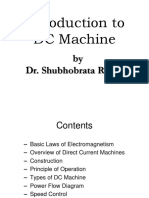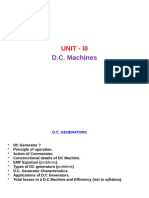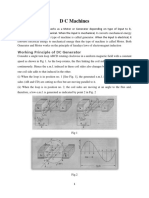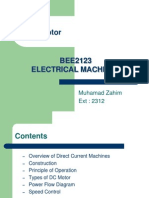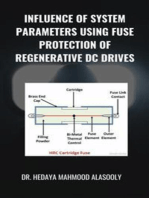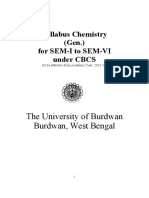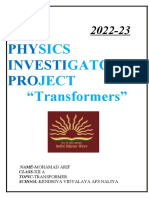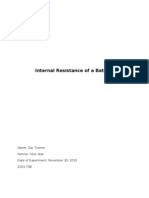Module 4
Uploaded by
princeshah11898Module 4
Uploaded by
princeshah11898Basic electrical engineering
D.C. Machines:
Syllabus: Working principle of D.C.Machine as a generator and a motor. Types,
constructional features and Types of armature windings. Emf equation of
generator, relation between induced Emf and terminal voltage with an enumeration
of brush contact drop and drop due to armature reaction. Operation of D.C. motor,
back Emf and its significance, torque equation. Types of D.C. motors,
characteristics and applications. Necessity of a starter for D.C. motor.
Introduction:
The converters which are used to continuously translate an electrical input to a
mechanical output or vice versa are called as DC machines.
If the conversion is from mechanical to electrical energy then it is called ad DC
Generator and if the conversion is from electrical to mechanical energy then it is
called as DC Motor.
Working principle of D.C.Machine as a generator and a motor:
Working principle of D.C.Machine as a generator:
Whenever a coil is rotated in a magnetic field an Emf will be induced in this coil and
is given by e=B*l*v*Sinθ volts/coil side where, B=The flux density in Tesla, l=the
active length of the coil side in meters v=the velocity with which the coil is moved in
meters/sec and θ is the angle between the direction of the flux and the direction of
rotation of the coil side.
The direction of the induced voltage can be ascertained by applying Fleming's right
hand rule.
Working principle of D.C.Machine as a motor:
Whenever a current coil is placed under a magnetic field the coil experiences a
mechanical force, and is given by F= B*I*l*Sinθ Newton/coil side where, I is the
current through the coil.
Applying Fleming's left hand rule, we note torque Te will be produced in the counter
clockwise direction causing the rotor to move in the same direction.
Construction of DC Machine:
Available At VTU HUB (Android App)
Basic electrical engineering
Salient parts of a D.C.Machine are:
(i) Field system (poles)
(ii) Coil arrangement (armature)
(iii)Commutator
(iv)Brushes
(v)Yoke
Yoke:
i) It serves the purpose of outermost cover of the D.C. machine. So that the insulating
materials get protected from harmful atmospheric elements like moisture, dust and various
gases like SO2, acidic fumes etc.
ii) It provides mechanical support to the poles.
iii) It forms a part of the magnetic circuit. It provides a path of low reluctance for magnetic
flux.
Poles:
Each pole is divided into two parts a) pole core and b) pole shoe
Pole core basically carries a field winding which is necessary to produce the flux.
It directs the flux produced through air gap to armature core, to the next pole.
Pole shoe enlarges the area of armature core to come across the flux, which is
necessary to produce larger induced emf. to achieve this, pole shoe has given a
particular shape
Field winding [F1-F2]:
The field winding is wound on the pole core with a definite direction.
To carry current due to which pole core on which the winding placed behave as an
electromagnet, producing necessary flux. As it helps in producing the magnetic field
i.e. exciting the pole as electromagnet it is called Field winding or Exciting winding.
Armature:
It is further divided into two parts
namely,
I) Armature core and
II) Armature winding
Armature core is cylindrical in shape mounted on the shaft. It consists of slots on its
periphery and the air ducts to permit the air flow through armature which serves
cooling purpose.
Commutator:
The basic nature of Emf induced in the armature conductors is alternating.
This needs rectifications in case of D.C. generator which is possible by device
called commutator.
GMIT, Bharathinagara Page 2
Available At VTU HUB (Android App)
Basic electrical engineering
Brushes and brush gear:
To collect current from commutator and make it available to the stationary external
circuit.
Ball bearings are usually used as they are more reliable.
For heavy duty machines, roller bearings are preferred.
Types of D.C. Armature Windings
Lap Winding Wave Winding
In this winding all the coils carrying current in
In this winding all the pole groups of
the same direction are connected in series i.e.,
the coils generating emf in the same
coils carrying current in one direction are
direction at any instant of time
connected in one series circuit and coils carrying
are connected in parallel by the brushes.
current in opposite direction are connected in
other series circuit.
2. Lap winding is also known as parallel 2. Wave winding is also known as series
windings. winding.
3. The number of parallel path is equal 3. The number of parallel paths is always equal
to the number of poles i.e., A = P. to 2 i.e., A = 2.
4. The number of brush required by this
4. The number of brushes required by this
winding is always equal to the number
winding is always equal to 2.
of poles.
5. The machine using lap winding 5. The machine using wave winding does
requires equalizer rings for obtaining require dummy coils to provide the mechanical
better commutation. balance for the armature.
6. Lap windings are used for low 6. Wave windings are used for high voltage and
voltage and high current machines. low current machines.
GMIT, Bharathinagara Page 3
Available At VTU HUB (Android App)
Basic electrical engineering
Emf Equation of DC Generator:
For one revolution of the conductor,
Let, Φ = Flux produced by each pole in weber (Wb) and
P = number of poles in the DC generator. Therefore,
Total flux produced by all the poles
Time taken to complete one revolution
Where, N = speed of the armature conductor in rpm.
Now, according to Faraday’s law of induction, the induced emf of the armature conductor is
denoted by “e” which is equal to rate of cutting the flux. Therefore,
Induced emf of one conductor is Induced emf of one conductor is
Let us suppose there are Z total numbers of conductor in a generator, and arranged in such a
manner that all parallel paths are always in series.
Here, Z = total numbers of conductor A = number of parallel paths
Then, Z/A = number of conductors connected in series
We know that induced Emf in each path is same across the line
Therefore, Induced Emf of DC generator E = Emf of one conductor × number of conductor
connected in series.
Induced Emf of DC generator is
Simple wave wound generator Numbers of parallel paths are only 2 = A Therefore,
Induced Emf for wave type of winding generator is
Simple lap-wound generator Here, number of parallel paths is equal to number of conductors
in one path i.e. P = A Therefore,
Induced Emf for lap-wound generator is
Available At VTU HUB (Android App)
Basic electrical engineering
Types of DC Generators
It is characterized by the manner in which field excitation is provided.
In general the method employed to connect field and armature winding has classify
into two groups.
Separately Excited Generators:
In separately excited dc machines, the field winding is supplied from a separate power
source. That means the field winding is electrically separated from the armature circuit.
Self Excited Field Generators:
This type of generator has produced a magnetic field by itself without DC sources
from an external.
The electromotive force that produced by generator at armature winding is supply to a
field winding (shunt field) instead of DC source from outside of the generator.
Therefore, field winding is necessary connected to the armature winding.
They may be further classified as: a) DC Shunt generator
b) DC Series generator
c) DC Compound generator.
a) Shunt generator:
This generator, shunt field winding and armature winding are connected in parallel
through commutator and carbon brush.
Available At VTU HUB (Android App)
Basic electrical engineering
b) Series generator:
The field winding and armature winding is connected in series.
There is different from shunt motor due to field winding is directly connected to the
electric applications (load).
Therefore, field winding conductor must be sized enough to carry the load current
consumption and the basic circuit
c) Compound generator :
The compound generator has provided with magnetic field in combine with excitation
of shunt and series field winding, the shunt field has many turns of fine wire and
caries of a small current, while the series field winding provided with a few turns of
heavy wire
ire since it is in series with an armature winding and caries the load current.
There are two types of Compound generators such as
(i) Long shunt Compound Generator
(ii) Short Shunt Compound Generator
Long Shunt Compound generator:
Short Shunt Compound Generator:
Available At VTU HUB (Android App)
Basic electrical engineering
DC Motors:
Operation of a DC motor:
When a DC machine is loaded as a motor, the rotor conductors carry current.
These conductors lie in the magnetic field of the air gap.
Thus, each conductor experiences a force.
The conductors lie near the surface of the rotor at a common radius from its centre
Hence, a torque is produced around the circumference of the rotor, and the rotor starts
rotating.
Back Emf and its Significance:
When the armature of a D.C. motor rotates under the influence of the driving torque,
the armature conductors move through the magnetic field and hence an emf is induced
in them.
The induced emf acts in opposite direction to the applied voltage V(Lenz’s law) and is
known as back emf.
Back EMF always acts to reduce the changing magnetic field through the coils. It
does so by generating a voltage which opposes the supply voltage, thus reducing the
current.
Significance:
The presence of back emf. makes the d.c. motor a self-regulating machine i.e., it
makes the motor to draw as much armature current as is just sufficient to develop the
torque required by the load.
Back emf in a D.C. motor regulates the flow of armature current i.e., it automatically
changes the armature current to meet the load requirement.
Types of DC Motors:
Motors are classified into 3 types: a) DC Shunt motor.
b) DC Series motor.
c) DC Compound motor.
a) DC Shunt motor:
In shunt wound motor the field winding is connected in parallel with armature.
The current through the shunt field winding is not the same as the armature current.
GMIT, Bharathinagara Page 7
Available At VTU HUB (Android App)
Basic electrical engineering
b) DC Series motor:
In series wound motor the field winding is connected in series with the armature.
Therefore, series field winding carries the armature current.
c) DC Compound motor:
Compound wound motor has two field windings; one connected in parallel with the
armature and the other in series with it.
There are two types of compound motor connections :
1) Short-shunt connection Compound Motor
GMIT, Bharathinagara Page 8
Available At VTU HUB (Android App)
Basic electrical engineering
When the shunt field winding is directly connected across the armature
terminals it is called short-shunt connection.
2) Long shunt connection Compound Motor
When the shunt winding is so connected that it shunts the series combination
of armature and series field it is called long-shunt connection.
Torque equation of a DC Motor:
Multiplying the equation (1) by Ia we get
Where,
VIa is the electrical power input to the armature.
I2aRa is the copper loss in the armature.
We know that, Total electrical power supplied to the armature = Mechanical power
developed by the armature + losses due to armature resistance
Now, the mechanical power developed by the armature is Pm.
GMIT, Bharathinagara Page 9
Available At VTU HUB (Android App)
Basic electrical engineering
Also, the mechanical power rotating armature can be given regarding torque T and speed n.
Where n is in revolution per seconds (rps) and T is in Newton-Meter.
Hence,
But,
Where N is the speed in revolution per minute (rpm) and
Where, n is the speed in (rps).
Therefore,
So, the torque equation is given as
GMIT, Bharathinagara Page 10
Available At VTU HUB (Android App)
Basic electrical engineering
Characteristics of DC Motors:
The three important characteristic curves are
1. Torque Vs Armature current characteristic (Ta/Ia)
2. Speed Vs Armature current characteristic (N/Ia)
3. Speed Vs Torque characteristic (N/Ta)
DC Shunt Motor Characteristics:
In this circuit the field winding is directly connected to the source voltage, so the field current
Ish and the flux in a shunt motor are constant.
Torque Vs Armature current characteristic (Ta/Ia):
We know that in a DC Motor Ta α ΦIa.
In this the flux Φ is continuous by ignoring the armature reaction, since the motor is working
from a continual source voltage
GMIT, Bharathinagara Page 11
Available At VTU HUB (Android App)
Basic electrical engineering
Speed Vs Armature current characteristic (N/Ia):
At normal condition the back EMF Eb and Flux Φ both are constant in a DC
Shunt motor.
Hence the armature current differs and the speed of a DC Shunt motor will
continue constant which is shown in the fig (dotted Line AB).
Whenever the shunt motor load is increased Eb=V-IaRa and flux reduces as a
result drop in the armature resistance and armature reaction.
On the other hand, back EMF reduces marginally more than that the speed of
the shunt motor decreases to some extent with load.
Speed Vs Torque characteristic (N/Ta):
The speed reduces when the load torque increases.
DC Series Motor:
GMIT, Bharathinagara Page 12
Available At VTU HUB (Android App)
Basic electrical engineering
Torque Vs Armature current characteristic (Ta/Ia):
We know that Ta ∝ ΦIa
Up to Magnetic Saturation Φ ∝ Ia, the armature torque Ta is directly proportional to
square of the armature current (i.e.. Ta ∝ I2a).
If armature current is doubled over, then armature torque is almost increasing
fourfold
Thus the armature torque vs. armature current curve up to magnetic saturation is a
parabola, which is shown in the characteristic curve OA.
On the other hand once the magnetic saturation is reached, the Ta is directly
proportional to the Ia.
As a result the armature torque vs. armature current magnetic saturation characteristic
is a straight line, which is shown in the curve AB.
Speed Vs Armature current characteristic (N/Ia):
The Series Motor Speed N is known as N α (Eb/Φ).
We know that back EMF Eb = V-Ia (Ra+Rse).
As soon as the Ia increases, the back EMF Eb reduced due to drop in Ia (Ra+Rse) even though
the flux increased. Still, Ia (Ra+Rse) is less in usual circumstance and might be vomited.
Therefore, N α (1/ Φ).
The speed vs. armature current characteristic follows the hyperbolic curve up to magnetic
saturation {α (1/ Φ)}.
GMIT, Bharathinagara Page 13
Available At VTU HUB (Android App)
Basic electrical engineering
In series motor the current flows in the field winding and the armature are same.
The armature current will increases whenever the mechanical load of the motor increase.
As a result the flux will increase in the series motor when the armature current increases and
vice versa.
Speed Vs Torque characteristic (N/Ta):
From this curve it is evident that the series motor runs at low speed when it develops
high torque and vice versa. .
This is due to the increase in armature torque need to increase the armature current
and also the field current.
As a result flux gets strengthened and drops the speed of the motor. If the speed gets
increased the torque must be low.
Characteristic of Compound motor:
Necessity of a Starter:
In a D.C motor whose armature is stationary is switched directly to its supply voltage,
it is likely that the fuses protecting the motor will burn out because the armature
resistance is small, frequently being less than one ohm.
Thus, additional resistance must be added to the armature circuit at the instant of
closing the switch to start the motor.
GMIT, Bharathinagara Page 14
Available At VTU HUB (Android App)
Basic electrical engineering
Back Emf create critical role in governing the operation of dc motor. Back
emf is generated as the motor armature start to rotate in presence of magnetic
field and it is counter to the supply voltage.
The back emf at the starting is zero and develops as the motor gradually
speed up.
We know that general emf equation E=Eb+laRa.
At starting Eb=0 so la=E/Ra, which indicates that current will be dangerously
high at starting (As Armature resistance Ra is small).Hence it is necessary to
use starter to limit the starting current to allowable lower value.
GMIT, Bharathinagara Page 15
Available At VTU HUB (Android App)
You might also like
- Introduction To DC Machine: by Dr. Shubhobrata RudraNo ratings yetIntroduction To DC Machine: by Dr. Shubhobrata Rudra129 pages
- Faraday's Laws of Electromagnetic InductionNo ratings yetFaraday's Laws of Electromagnetic Induction31 pages
- Chapter 7: D.C MACHINES: INTRODUCTION: DC Generators and Motors Are Collectively Known AsNo ratings yetChapter 7: D.C MACHINES: INTRODUCTION: DC Generators and Motors Are Collectively Known As13 pages
- Introduction To Electrical Engineering Module 3 1No ratings yetIntroduction To Electrical Engineering Module 3 145 pages
- BT-104 Unit-4 Important Questions With Solutions - 2024No ratings yetBT-104 Unit-4 Important Questions With Solutions - 202420 pages
- Basic Construction and Working of A DC GeneratorNo ratings yetBasic Construction and Working of A DC Generator12 pages
- DC Machines: Saravanan T Y Assistant Professor EEE Department Nararana Engineering College GudurNo ratings yetDC Machines: Saravanan T Y Assistant Professor EEE Department Nararana Engineering College Gudur34 pages
- DC Machines: The Action of A CommuttatorNo ratings yetDC Machines: The Action of A Commuttator5 pages
- Influence of System Parameters Using Fuse Protection of Regenerative DC DrivesFrom EverandInfluence of System Parameters Using Fuse Protection of Regenerative DC DrivesNo ratings yet
- Small Dynamos and How to Make Them - Practical Instruction on Building a Variety of Machines Including Electric MotorsFrom EverandSmall Dynamos and How to Make Them - Practical Instruction on Building a Variety of Machines Including Electric MotorsNo ratings yet
- Notes - Topic 3 Electric Circuits - Edexcel Physics A-Level100% (1)Notes - Topic 3 Electric Circuits - Edexcel Physics A-Level11 pages
- Uan Expt 1 The DC Shunt Generator ModifiedNo ratings yetUan Expt 1 The DC Shunt Generator Modified8 pages
- 16 12th Physics Important Questions English MediumNo ratings yet16 12th Physics Important Questions English Medium11 pages
- Electrical Design - Dax Generators: © BRUSH GroupNo ratings yetElectrical Design - Dax Generators: © BRUSH Group66 pages
- XII Current Electricity QN Ans - 230914 - 115259No ratings yetXII Current Electricity QN Ans - 230914 - 11525926 pages
- Cpac3 Determining Emf and Internal ResistanceNo ratings yetCpac3 Determining Emf and Internal Resistance3 pages
- Xii Physics-Investigatory Project TransformerNo ratings yetXii Physics-Investigatory Project Transformer16 pages
- Introduction To DC Machine: by Dr. Shubhobrata RudraIntroduction To DC Machine: by Dr. Shubhobrata Rudra
- Chapter 7: D.C MACHINES: INTRODUCTION: DC Generators and Motors Are Collectively Known AsChapter 7: D.C MACHINES: INTRODUCTION: DC Generators and Motors Are Collectively Known As
- BT-104 Unit-4 Important Questions With Solutions - 2024BT-104 Unit-4 Important Questions With Solutions - 2024
- DC Machines: Saravanan T Y Assistant Professor EEE Department Nararana Engineering College GudurDC Machines: Saravanan T Y Assistant Professor EEE Department Nararana Engineering College Gudur
- Influence of System Parameters Using Fuse Protection of Regenerative DC DrivesFrom EverandInfluence of System Parameters Using Fuse Protection of Regenerative DC Drives
- Small Dynamos and How to Make Them - Practical Instruction on Building a Variety of Machines Including Electric MotorsFrom EverandSmall Dynamos and How to Make Them - Practical Instruction on Building a Variety of Machines Including Electric Motors
- Notes - Topic 3 Electric Circuits - Edexcel Physics A-LevelNotes - Topic 3 Electric Circuits - Edexcel Physics A-Level
- 16 12th Physics Important Questions English Medium16 12th Physics Important Questions English Medium


